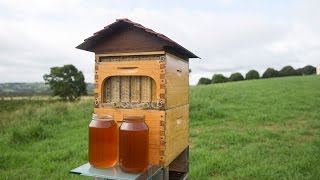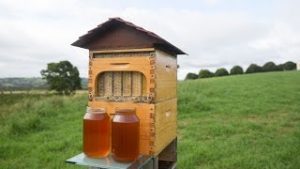The Flow Hive™ has captured the attention of the bee world. It often comes up as a question in bee meetings and bee schools. People mostly have questions and also lots of opinions upon hearing about it. Labeled “the Holy Grail of Beekeeping,” it has been self-proclaimed “the most significant invention in beekeeping since 1852” by the website www.honeyflow.com The video of this new super has been ‘liked’ over 175,000 times on Facebook and an indiegogo fund raiser garnered over $12 million from over 36,000 funders.
This new super was 10 years in the making and 3 years in testing. If you haven’t seen it view the video on https://www.indiegogo.com/projects/flow-hive–honey-on-tap-directly-from-your-beehive#/story . On the same site you can purchase an entire honey super ($670) or 3 frames for your Langstroth 8-frame box ($260) or 4 frames for a 10-frame Langstroth ($315). Shipment, has been slow, despite the great funding success. Early fund pledgers will get their Flow hive/frames later this year. Current orders are promised by February 2016.
A British Journal BEE CRAFT author Stuart Anderson asked the Flow Hive™ developers 20 questions for their May frames are only partially plastic and bees’ way of life is in no way affected by having the combs partially constructed of plastic”; “the plastic is durable”; ”the bees are not at all disturbed by the harvesting process. They seem to have no idea that it’s happening”; “the honey comes out remarkably clear. There’s no filtering required” (though presumably some capping wax will flow out with the honey into the collection jars); “beekeepers can pull out the Flow frames to check if ready” (i.e. to check if cells fully capped).
To a questions about mixing ordinary frames with flow frames, the developers (dad Stuart and son Cedric Anderson of Australia) responded: “we’d recommend leaving those for winter bee feed and harvesting only the Flow frames.” When asked about crystallized honey they indicated: “We found that if we tried to operate a crystallised Flow frame it would crack a little, the bees would notice the breaks and would go about consuming the crystallised honey and replace it with honey that was more fluid.” (NOTE: How would crystalized canola or other not very viscous Oregon honey be treated)?
Two questions I would have asked were about brood in the frames or propolize affecting the mechanism. The developers indicated they have had drone brood, but never worker brood in the Flow hive frames and “the honey flows past and over them to the collection trough”. To the question about propolis they claim “the bees never put it (propolis) in the wax honeycomb itself and since the mechanism of the Flow frames is deep within the hexagonal wax honeycomb…the bees do not try to glue it up.”
I liked the author’s final question (and the response): “If I use Flow frames does that mean that I do not have to do anything else to my bees except run off the honey?” Response: “NO Flow hives …should be checked regularly for pests, disease and anything else -…people who are new to beekeeping need to learn how to take care of their bees. The Flow hive simply addresses the expense, mess and effort associated with the honey harvesting process.” This month as many of us do that “annual struggle” those are welcome words indeed!!
New technology is going to be expensive – if you have markets where honey sells for gold/platinum prices and you have not invested yet in an extractor perhaps this ‘contraption’ might be worth the price? The big question remains ‘Will it work?’ I am sure investors in Langstroth hives or purchasers of Italian queen had the same question back in the late 1800s. The patent world is full of lots of great devices for bees that none of us have even heard of nor use.


